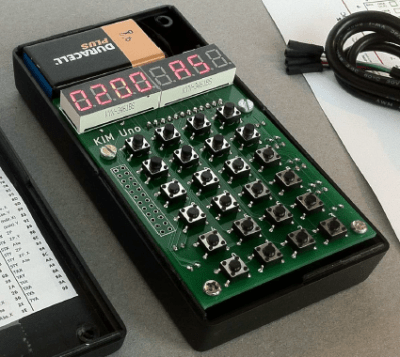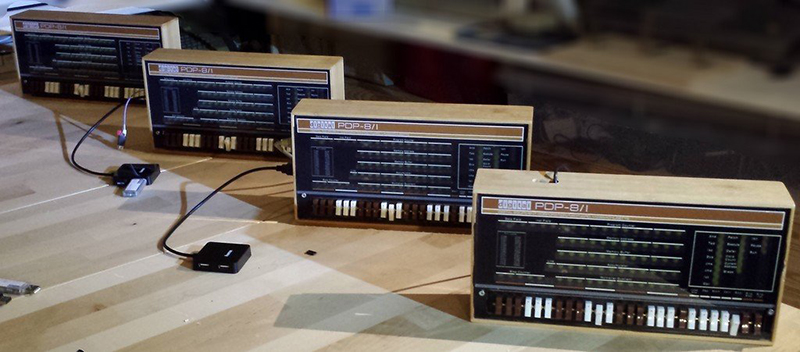This year’s Hackaday Prize included a category for the Best Product, and there is perhaps no project that has inspired more people to throw money at their computer screens than [Oscar Vermeulen]’s PiDP-8/I. It’s a replica of the PDP-8/I from 1968. Instead of discrete electronics driving the blinkenlights and switches on the front of this computer, [Oscar]’s version uses a Raspberry Pi and the incredible SIMH emulator for dozens of old mainframes and minicomputers. It is, for all intents and purposes, a miniaturized version of a 50 year old computer that will fit on your desk and is powered by a phone charger.
Check out the video of [Oscar]’s talk below then join us after the break for more discussion of his work.
[Oscar], like a few Hackaday readers, has been collecting computers for a few decades now, but in all that hoarding one computer has escaped his collection: the PDP-8/I. This computer, loaded up with switches and blinkenlights is almost friendly in appearance, and according to everyone who used it as their first computer, was even more accessible than it looked.
[Oscar] wanted one of these machines, but one with the proper vintage is huge and expensive. A decade ago, Spare Time Gizmos came out with a reproduction of a PDP-8, but this required a rather rare chip. Surely, with tiny Linux boards and emulators [Oscar] could build something to give him a taste for the PDP.

This wasn’t [Oscar]’s first venture into reproducing classic computers. A few years ago, he built the KIM Uno, a replica of the KIM-1 that used a few buttons, resistors, seven-segment displays and an Arduino pro mini.
While the KIM Uno emulated the original 6502 single board computer from 1976, it wasn’t really a successful product. It was, after all, just a bunch of buttons and LEDs – not something that could earn its place on a mantle or shelf.
[Oscar]’s attention then turned to the idea of a replica of the PDP-8. With a Raspberry Pi, simulation was easy and had enough GPIOs to blink some LEDs and read some switches. This meant designing a kit for the PiDP, and developing a kit is a completely different process than designing a project for yourself. A lot of optimization needs to happen, and he needed to make the entire kit idiot proof.
Turning this project into a product meant a few lessons needed to be learned. The cost of parts includes the cost of failures, and the cheapest parts usually aren’t the least expensive. Standard parts, and not 1980s ex-Chinese Army components like he used on his first run, should be used.
![The PDP-11/70, [Oscar]'s next project](https://hackaday.com/wp-content/uploads/2015/12/11-70.jpg?w=400)
The next project [Oscar] has up his sleeve is a PiDP-11/70, the king of the PDPs, and possibly the most beautiful computer ever to come out of Maynard, Massachusetts. This requires a bit more engineering than the PiDP-8/I; there’s going to be a vacuum formed bezel going around the entire computer, and the switches – beautiful red and burgundy toggle switches – are going to be custom made.
Will [Oscar]’s latest project be a success? Probably; he’s already sold one thousand PiDP-8/Is, and everyone with an ounce of respect for retrocomputing lusts after the 11/70. In any event, turning a simple project like the 8/I into a real product has taught [Oscar] a lot of valuable lessons, and things will surely go easier this time around.
















Oscar has a real talent for producing kits. I’m looking forward to the PiPDP-11. The PiPDP8/1 kit was fantastic. I was in the first round and the kit was super easy to build and ran flawlessly right out of the gate. Can’t wait for the next one!
I’d also venture to say his KIM UNO was also somewhat successful. I’ve got one and it gets more use than my original KIM-1. It’s got a spot on my desk beside the PiPDP-8.
Here’s a KIM Uno from [Oscar] that I put together.
http://cdn.hackaday.io/images/4177831449371860045.jpg
It currently runs on batteries but I am going to put a cheap rechargeable power bank into it.
I like the VCF-Mid West 10 t-Shirt being worn. :)
i love when a video of the presentation shows the dude 99% of the time and we don’t see the slides that he shows stuff on. how the guy looks like is the least important thing, why would they focus most of the time on him?
I sure have to agree with you there.
I have the PDP-8 Intersil Cmos chip set Processor, 12x4k ram, etc.. I never got around to building it. If someone is interested in making a more accurate PDP -8 leave a PM and I will send it to you.
I’m interested, able to ship to Germany?
I would give Oscar first crack. He’s a proven fanboy of the PDP.
Yeah, good call.
+1
My favorite quote from the presentation. “… there is no product obscure enough that people are not interested in it…”
Tell me about it… http://arduinoenigma.blogspot.com
hi… great article… I just wish you had included Oscars website URL…… cause I need another out of date machine in the house to get told about.. :)